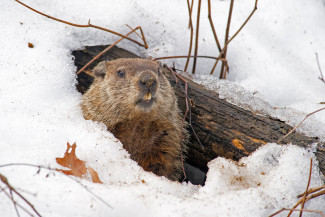
Johns Hopkins UniversityEst. 1876
America’s First Research University
What Does the Groundhog Really Reveal on February 2


Winter-weary reporters scurry on Groundhog Day, February 2, to answer the pressing question of whether spring will arrive early. Most cameras focus on a prognosticating groundhog emerging from its burrow in Punxsutawney, Pennsylvania, but they can also point to festivities in hamlets from New York across to California and the Canadian Maritimes down to the Gulf Coast. The celebration, and often humorous prognostication, owes to the Pennsylvania Germans who first settled in southeastern Pennsylvania in the eighteenth century and then spread throughout North America. To this day, the groundhog has become a symbol of Pennsylvania German identity evident in Groundhog lodge meetings and Fersommlinge (banquet gatherings in which the Pennsylvania German language is exclusively spoken), parties for Pennsylvania expatriates, Groundhog Day parades in the “Dutch Country,” and plenty of effigies and smiling images of the groundhog. There are even “spokesgroundhogs” for the Pennsylvania Lottery named Gus and Gabby.
The Groundhog Day phenomenon is one of many in North America with a Pennsylvania German origin story of which many people are unaware, and it carries important lessons for our modern day. We can add other popular American traditions such as the Christmas tree; Easter bunny; foods such as scrapple, pot pie, shoofly pie, and funnel cake; and bank barns on the landscape. The lowly groundhog has become symbolic for Pennsylvania Germans not only because of its connection to adaptation in the New World (in their European homelands, the prognosticator would likely have been the badger or bear), but also because it represents an often maligned rural dweller who has reproduced widely, although it is often out of view. Pennsylvania Germans hold the groundhog aloft with dry humor, but also express concerns for their identity as viewed by themselves and others over their more than three-century legacy in North America.
Groundhog Day with all its profound implications for Americans generally and Pennsylvania Germans specifically is one of the many cultural features attached to Pennsylvania Germans explored in Pennsylvania Germans: An Interpretive Encyclopedia that we edited. While Josh teaching in Wisconsin is keeping an eye on Jimmie the Groundhog in Sun Prairie and Simon in Pennsylvania is checking on Octorara Orphie in Quarryville, Lancaster County, you can read about the representation of Groundhog Day affecting a more diasporic, transnational consideration of Pennsylvania German identity in Diane Wenger’s chapter on twentieth-century historical developments, the importance of Fersommlinge in the perpetuation of the Pennsylvania German language in Mark Louden’s chapter on language, the rise of “groundhog culture” in Simon Bronner’s chapter on folklore, the history and ritual of groundhog lodges in William Donner’s chapter on heritage and tourism, and of course the media frenzy over Punxsutawny Phil in the news, film, and stage in Simon Bronner’s concluding chapter on popular culture and media. So pass the Dutch pretzels, respect the groundhog (yeah, that’s an inside joke sported on t-shirts and calendars in the Dutch country!), and pore over all things Pennsylvania German in our reference work, which we worked to be the most comprehensive to date. We predict that you will learn not only about Pennsylvania German contributions to American culture, past and present, but also the meaning, and implications, of the group’s changing, diasporic identity.
Simon J. Bronner is distinguished professor of American studies and folklore and the director of the Center for Pennsylvania Culture Studies at the Pennsylvania State University, Harrisburg. He is the author of Explaining Traditions: Folk Behavior in Modern Culture and the editor of Encyclopedia of American Folklife. Joshua R. Brown is associate professor of German at the University of Wisconsin–Eau Claire. He is a coeditor of The Comprehensive Pennsylvania German Dictionary. Their co-edited book, Pennsylvania Germans: An Interpretive Encyclopedia, is available now.


